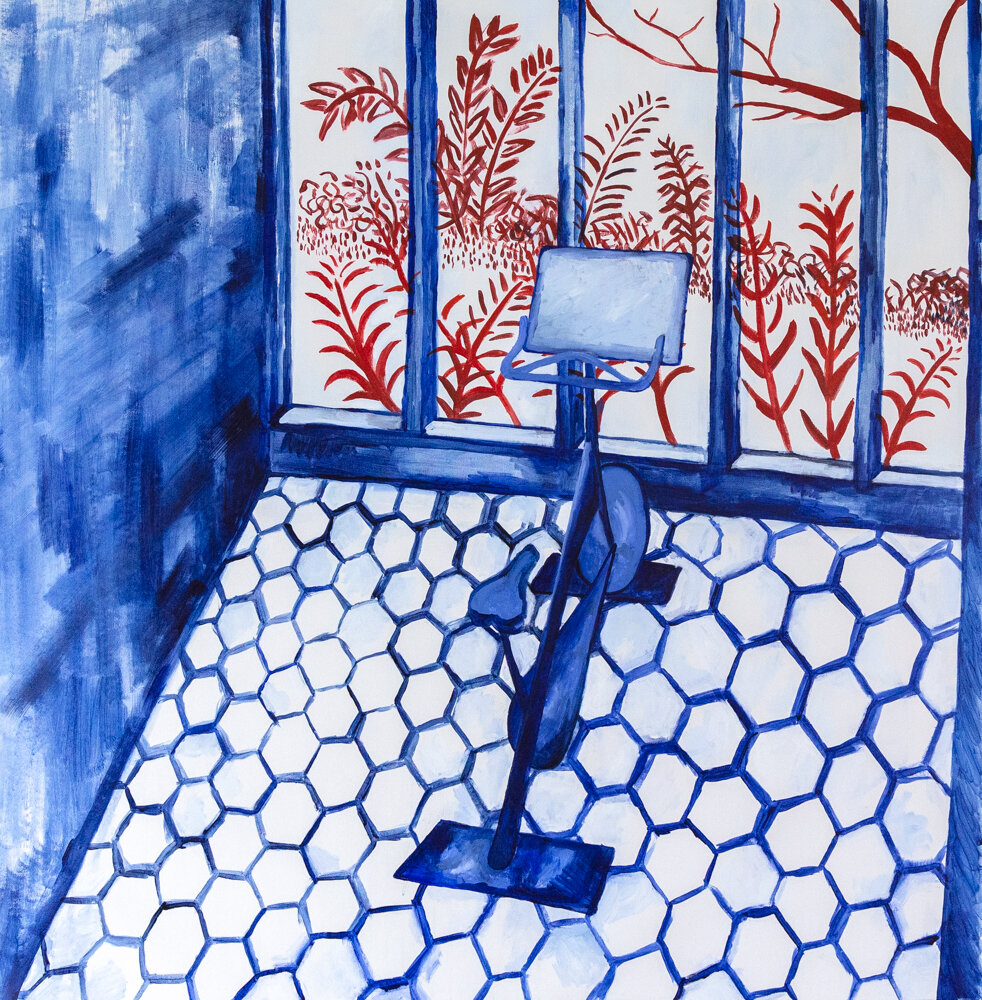I recently completed “From the Cave” - my first artwork intended for a larger public and funded by a grant. It was an installation and an online performance - two categories that were also new to me.
The grant application was surprisingly helpful to the project as it encouraged me to be specific. I went from having a vague idea of what I wanted to do, to having a very clear vision. The deadline also helped me push through moments of indecision.
I drafted and submitted the project proposal to the City of Houston’s “Let Creativity Happen! Digital grant program” in April 2021. A few months later, I received the panel’s decision, and by August the project had begun.
Installation plan for From the Cave which was included in the project proposal.
The idea behind “From the Cave” was a product of the past year (and a half) - particularly the isolation during the early stages of the pandemic.
Prior to the cave, I had begun exploring the relationships between technology, nature, and the self. I was studying the spaces I inhabited - the self’s interior and the exterior, physical space. My paintings used red and blue to juxtapose the harmony and tension between these elements. I found these two colors to be very interesting to play with. i associated red with blood, earth, and urgency and blue with distance, technology, and isolation.
By late spring 2020, there was some hope that things would soon return to “normal”. (This turned out not to be the case due to the Delta variant.) I was excited and grateful. But, I was also anxious. I was socially out of practice and staying at home had become comfortable. By this point, I was used to living behind a screen, having control over my everyday encounters, and experiencing new things with at least an arm’s distance.
I also knew that trapping myself with myself and my screens (almost like a hall of mirrors - think Trick Mirror by Jia Tolentino) had been unhealthy and possibly (or most certainly) altered my sense of reality. This led me to Plato’s cave.
The Allegory of the Cave became a powerful means of looking at the reality constructed by the tools (or more specifically the media, or more specifically the Net) we had become engrossed with.
I chose to limit my color palette to red and blue which felt instinctive by this point. Red, alluding to earth, origin, and blood, would be the physical world outside the cave, and blue, alluding to isolation, distance, and electricity, would be the digital illusionary world that made up the cave.
Embracing the concept of the cave, I also wanted to refer back to Paleolithic cave paintings - some of the earliest forms of human expression and depictions of the world (36,000+ years old). The paintings of the Chauvet and Lascaux Caves are well documented examples. (The Chauvet Cave was beautifully portrayed by Werner Herzog in The Cave of Forgotten Dreams.) In conversation with these cave paintings, I would embrace gesture - a style that I admire as it is very human, expressive, and liberating.
In these caves, earth pigments of red, yellow, white, and black were used. In similar fashion, I would use red oxide, white, and mars black. I wanted to touch upon painting’s legacy and give a feeling of humanness and earth.
Project color palette. From left: red oxide, burnt sienna, titanium white, mars black, raw umber, phthalo blue.
Of course, caves are naturally dark, so cave dwellers used fire to illuminate the space around them. Torches were their means of seeing. Like the cave dwellers of the Paleolithic Era, people of the 21st century use(d) the screens of their digital devices to see.
To highlight this continuity and contrast, I decided to paint in the dark and use the screens of my digital devices as my light source.
From the Cave, August 24, 2021, photographed by Erica Lee.
A key component of this year grant’s cycle was digital accessibility - large public gatherings were hazardous due to Covid-19. The idea that sparked the project, however, challenged the ubiquity and authenticity of digital experiences. The irony and tension that resulted became a curious element of the project.
The dark and isolated setting, the use of digital devices for light, the process of painting, and the project’s overall dependence on the Net to connect with the outside world formed the foundation of the performance.
I painted the “cave” late in the evening over the course of two weeks. I made the performance digitally accessible by hosting livestreams while I painted and sharing social media posts regularly. Once the installation was complete, I hosted a livestream walkthrough of the installation. Afterwards, I created the website where the installation and performance would continue to live online. From here, viewers could observe the cave from their digital screens - the very tool that had constituted the cave.
This process, which had been drafted thoroughly for the grant application, became essence of the project. While planning the process admittedly felt a bit like schoolwork, it created momentum and inspired me to look and build upon the original concept.
In the coming weeks, I will share the surprises I encountered, what I learned along the way, and what the project means for my art practice going forward.
Resources
Bruno, David. Cave Art. London: Thames & Hudson, 2017.
Plato. Republic. Translated by Reeve, C. D. C. Indianapolis: Hackett Pub. Co., 2004.
Plato. “The Allegory of the Cave, Republic, VII 514 a, 2 to 517 a, 7.” Translated by Thomas Sheehan. Accessed 2021. https://web.stanford.edu/class/ihum40/cave.pdf.
To continue reading about the project, please visit the second post.

